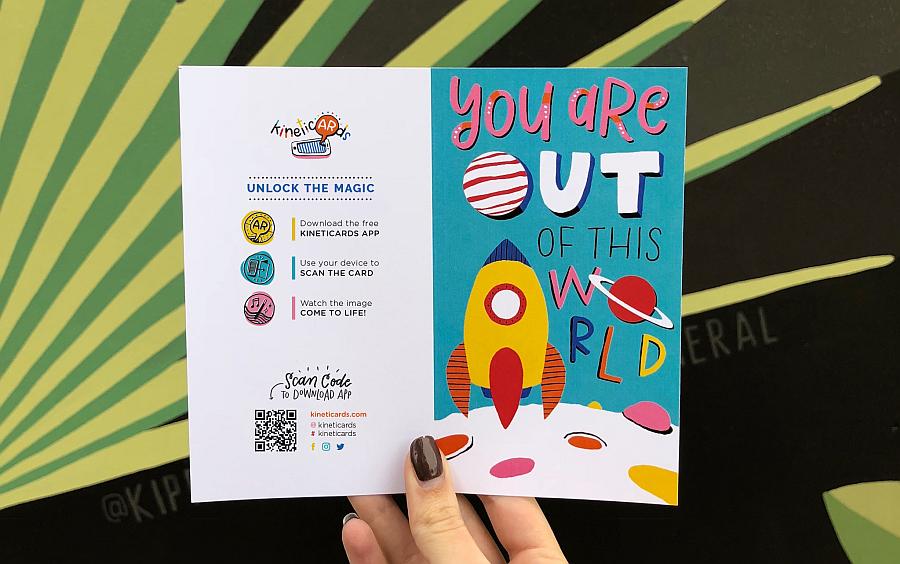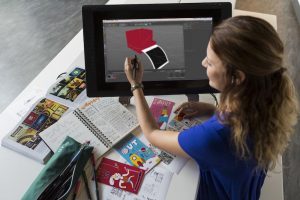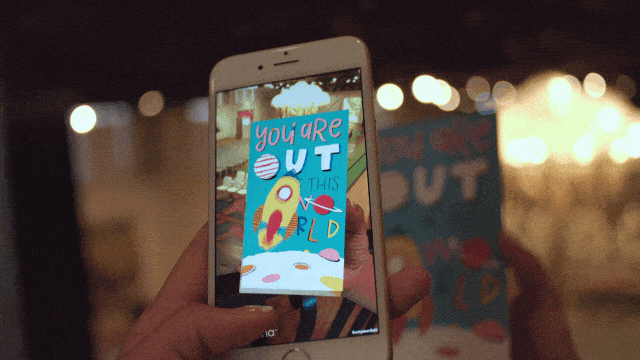L’augmentation des imprimés est un thème récurrent de la réalité augmentée et de nouvelles applications semblent apparaître régulièrement. Je vous propose aujourd’hui d’aller échanger quelques mots avec Chrissy Eckman, la fondatrice de Kineticards, qui nous explique pourquoi il est important aujourd’hui de « matérialiser » certains échanges et comment la réalité augmentée peut y apporter une vraie magie.
Hello Chrissy, thank you for taking the time to speak with us. Would you mind telling us a little bit about yourself?
Hiya! It’s a pleasure chatting with you. I am a designer and entrepreneur with interests in both print and digital media — my backgrounds are in graphic design and animation, which I studied at the Savannah College of Art and Design (SCAD). My favorite things in life are cats, coffee, and chocolate. 🙂
As the creator of Kineticards, could you tell us how you came up with the concept?
 It all began during my final semester of college, where I knew I wanted to create a project that combined all of my favorite skills: hand-lettering, illustration, short looping animations, and branding/marketing surrounding the concept. I originally planned on starting a website of eCards, but a friend of mine suggested using augmented reality to combine the physical + digital worlds instead. I loved that idea because it presented the exciting challenge of learning AR, and the concept itself was much more appealing with a tangible product. I have always been a huge fan of snail mail, so it meant a lot to me to design something that would encourage people to take the time to handwrite messages and strengthen their physical connections in such a digitally-focused era.
It all began during my final semester of college, where I knew I wanted to create a project that combined all of my favorite skills: hand-lettering, illustration, short looping animations, and branding/marketing surrounding the concept. I originally planned on starting a website of eCards, but a friend of mine suggested using augmented reality to combine the physical + digital worlds instead. I loved that idea because it presented the exciting challenge of learning AR, and the concept itself was much more appealing with a tangible product. I have always been a huge fan of snail mail, so it meant a lot to me to design something that would encourage people to take the time to handwrite messages and strengthen their physical connections in such a digitally-focused era.
What other possibilities do you see for Kineticards?
Ah, so many possibilities! Right now, we’re focusing on product development for our wholesale line so we can get Kineticards into the hands of as many consumers as possible. We’re exploring how other products can work with AR as well — gift wrap, keychains, balloons, coasters to name a few — and we’re excited to see where that goes. On the app side of things, we also plan on expanding the user experience so people can hold onto their memories and create new ones more easily.
Do you work alone or in a small team when creating Kineticards?
I typically do work alone in designing cards and handling orders + outreach nowadays, but Kineticards as a company was built with many more hands than just my own! I worked with a team of awesome developers to help bring the app to life, and I’ve had a few other artists help out with bits of designing and animating more recently. A friend of mine also creates custom audio tracks for some of the newer cards. Everyone else works remotely though, and I pull them on as needed.

What made you choose using a physical greeting card to support augmentation instead of photos or books etc? Do you think in this era of being a mostly “dematerialized” world people feel like to keep “materialized” messages?
Greeting cards are important to me because of how personal they are. Cards encourage people to think about their loved ones and take the time to write messages from their hearts that can be held onto and cherished forever. I think it’s even more special to receive a physical note in this “dematerialized” era because of how uncommon it has become, and I hope that Kineticards help people not lose interest in greeting cards for that reason.
In general, what do you think the future of printed physical objects will be? Do you think that more things will become augmented?
Although so many pieces of our world are becoming digitized versions of what they used to be, I still think there will always be a need, or at least a preference, for printed design in certain spaces. However, it certainly has its limitations in a lot of ways that technology can help improve. AR allows us to expand upon what already exists in the physical world and bring a new level of interactivity to static physical objects — I believe it will find applications across all kinds of different fields. It’s exciting to think about all the possibilities!
Where do you see the future evolution of Kineticards going?
I have a few big announcements up my sleeve regarding the future of Kineticards, but I’m not ready to share them *quite* yet. You’ll have to follow along to keep in touch with the latest updates 🙂 Become our friend on social media — @kineticards — and you’ll be the first to know!
Many thanks Chrissy for your time! Readers, please, go to kineticards.com to see the latest cards available and share it with love!
PS : Thanks for you help Liana (vicariouspr.com)
Grégory MAUBON est consultant indépendant en réalité augmentée (animateur et conférencier) depuis 2008, où il a créé www.augmented-reality.fr et fondé en 2010 RA'pro (l'association francophone de promotion de la réalité augmentée). Il a aidé de nombreuses entreprises (dans plusieurs domaines) à définir précisément leurs besoins en réalité augmentée et les a accompagnées dans la mise en œuvre.



